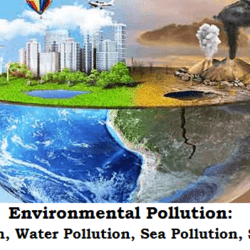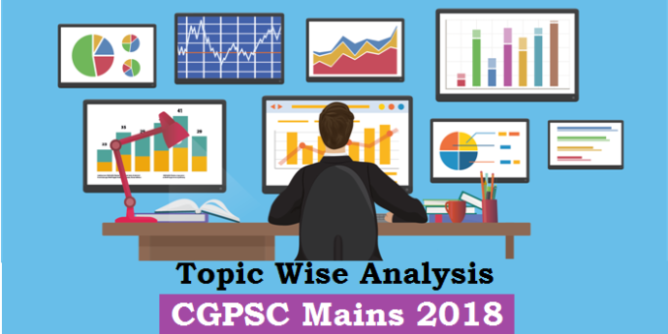
Here is our topic-wise analysis of recently conducted CGPSC Mains 2018. The topics from the syllabus which were asked directly or indirectly are also mentioned. The bold topics are newly introduced from Mains 2018.
As suggested in this post, about 55% questions were directly asked from the topics of the syllabus and 35% questions were related with the topics which are an obvious part of the respective syllabus topics. Therefore, covering the syllabus itself prepares you to solve about 90% of the questions.
Note: This analysis includes the optional questions also: One 10 marks and two 15 marks questions. Therefore, for calculation purpose total marks for a single paper is 240 marks.
Paper-I (Languages): 200 Marks
| Part- 01 हिंदी: 100 Marks
- हिंदी व्याकरण: 50 Marks
- पत्र लेखन: 0 Marks
- हिन्दी साहित्य: 08 Marks
- छत्तीसगढ साहित्य: 06 Marks
- अपठित गद्यांश: 06 Marks
- प्रारूप प्रतिवेदन एवं लेखन: 20 Marks
- अनुवाद: 10 Marks
| Part- 02 General English: 50 Marks
- Comprehension: 06 Marks
- Précis Writing: 06 Marks
- English Grammar: 38 Marks
| Part- 03 Chhattisgarhi Language: 50 Marks
- छत्तीसगढ़ी भाषा: 8 Marks
- छत्तीसगढ़ी साहित्य: 9 Marks
- छत्तीसगढ़ी का व्याकरण: 28 Marks
- छत्तीसगढ़ी भाषा का विकास में भूमिका: 5 Marks
Paper- II (Essays): 200 Marks
International and National level issues: 3 out of 4 topics were easy to be guessed as they were frequently discussed in the country, while Sustainable development is an evergreen topic for essay and interview.
- Unemployment and economy
- Internet age and society
- Indian space mission
- Sustainable development
Chhattisgarh State Level issues: 2 topics- Industry and tribals and NGGB Scheme were frequently discussed. Livelihood issue is an evergreen topic for the state like Naxalism and Rural economy.
- Industry and tribals
- Digital opportunities
- Narva, Garua, Ghuruva and Badi (NGGB) Scheme
- Livelihood College
Paper- III: General Studies- I (History, Constitution and Public Administration): 200 Marks
| Part 01: History of India: 75 Marks
Ancient History: 21 Marks
- Indus Civilization: 2
- Vedic Civilization: 2
- Jainism and Buddhism: 2
- Gupta Empire: 15
Medieval History: 28 Marks
- Sultanate and mughal period: 2+2
- Vijaya Nagar Kingdom: 4
- Rise of Marathas:2+8
- Bhakti Movement: 8
- Sufism: 2
Modern India: 41 Marks
- Advent of Europeans and factors responsible for the establishment of British Supremacy: 2
- Expansion of British Empire- Wars and diplomacy: 4
- Rural Economy-Agriculture: 4
- Land Revenue Systems- Permanent Settlement, Ryotwari, Mahalwari: 4
- Rise of Nationalism
- Establishment of Indian National Congress: 4
- Reform movement among Dalits: 8
- Reform movement among Muslims, Aligarh Movement: 15
| Part 02: Constitution and Public Administration: 50 Marks
Constitution of India: 20 Marks
- Formation of the Constitution and Salient Features: 2
- Union Executive: 4+8
- Right to Constitutional Remedies:4
- Constitutional Amendments: 2
Govt. of Chhattisgarh: 28 Marks
- Legislative: 8+10
- Executive and Judiciary: 10
Public Administration: 12 Marks
- Development Administration and Comparative Administration: 2.
- Instruments of Administrative Management- Co-ordination, Delegation, Communication, Observation (or Supervision) and Motivation: 2
- Good Governance: 2
- District Administration: 4
- Parliamentary- Presidential: 2
| Part 03: History of Chhattisgarh: 75 Marks
- Pre-historic Age: 2
- History of Chhattisgarh from Vedic age to Gupta Period: 2
- Major dynasties of Chhattisgarh: 18 Marks
- Nala: 4
- Sharabhpuriyas:2
- Somvanshis: 8
- Chindak Nag: 4
- The Kalchuris and their Administration:2
- Chhattisgarh under the Marathas: 4+15
- Chhattisgarh under British protectorate: 2
- Revolt of 1857: 2
- Freedom Movement in Chhattisgarh: 45 Marks
- Jungle satyagraha: 8
- Quit India movement:2+4+15
- Role of individuals: 8
- Workers, Peasant and Tribal Movements: 2+4
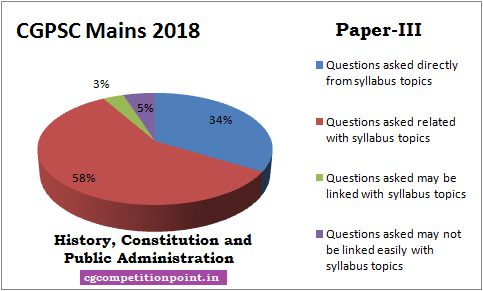
| Analysis |
| Questions asked directly from syllabus topics: 2+2+2+2+2+2+2+2+4+4+4+4+8+8+8+10+15= 81 Questions asked related with syllabus topics: 2+2+2+2+2+2+2+2+2+2+2+4+4+4+4+4+4+4+4+8+8+8+8+8+15+15+15=139 Questions asked may be linked with syllabus topics: 2+2+4=8 Questions asked may not be linked easily with syllabus topics: 2+10= 12 |
Paper– IV: General Studies- II (Science, Aptitude and Environment): 200 Marks
| Part 01 General Science: 75 Marks
Chemistry:
- Metals:
- Metallurgy-concentration, roasting, smelting, refining of ores: 4
- Metallurgy of copper and Iron: 2+8
- Alloys: 2
- Some general artificial polymers, polythene: 2
Physics:
- Light:
- Nature of light reflection of light: 2
- Laws of reflection: 2
- Electricity and its effects:
- electric intensity, potential, potential difference: 4
- combination of resistance and related numerical examples: 4
- Photo electric effect: 15
- Solar Cell: 2
- Structure, PN Junction Diode: 8
Biology:
- Transport:
- structure and working of heart (preliminary knowledge): 15
- Photosynthesis:
- Light reaction and dark reaction: 4
- Respiration:
- respiratory system of human being and mechanism of respiration (general information): 8
- Control and coordination:
- Nervous system of human being: 2
- Reproduction and growth:
- Type of reproduction Asexual reproduction fission, budding, regeneration, vegetative reproduction, layering, cutting, grafting: 2
- Porthenogenesis, sexual reproduction in plants: 2
- Heredity and evolution:
- heredity and variation: 4
| Part 02 Aptitude Test, Logical Reasoning, Mental Ability: 50 Marks
Basic Mathematics:
- Ratio and Proportion:
- Definition, properties, alternendo, invertendo, componendo, etc. and their uses: 2+2+4
- Factorization:
- LCM and HCF: 2
- Arithmetic mean, median: 2+8
Vedic Mathematics:
- Vedic Mathematic, additional, subtraction, multiplication, division and checking the answer through bijank: 4
- Introduction and creativity of Indian Mathematicians in reference with
- Aryabhata, Varahamihira, Brahmagupta, Bhaskaracharya, Shrinivas Ramanujan: : 10
Data Analysis:
- Mathematical operation Basic numeracy (numbers and their relations, orders of magnitude etc.): 8
- Data interpretation (charts, graphs, tables, data sufficiency etc.) and analysis of data: 4+10.
Applied Mathematics:
- Profit and Loss, Percentage: 2
- Probability, Question related to addition and multiplication theorem on probability: 2
| Part 03 Applied & Behavioural Science: 75 Marks
Technology:
- Role of Information Technology in Rural India: 15,
- basic knowledge of computers: 2+4
- software development for economic growth: 2
- Energy Resources:
- renewable and nonrenewable energy resources: 2+2+4+4
- Current Science and Technology developments in India: 4
- Progress of Agricultural Science and its impacts: 2
Environment:
- Bio-diversity and its conservation:
- India as a wide diversity nation: 15
- Hotspots of Biodiversity: 4
- threats to biodiversity: 2
- humans and wild animals struggle: 8
- Environmental pollution: Cause, effect and control measures-
- water pollution: 2
- nuclear pollution: 8
- Solid waste management:
- Urban and Industrial solid waste management: reason, effect and control: 8

| Analysis |
| Questions asked directly from syllabus topics: 2+2+2+2+2+2+2+2+2+2+2+2+2+2+2+4+4+4+4+4+8+8+8+8+8+8+8+8+10+10+15+15+15= 179 Questions asked related with syllabus topics: 2+2+2+2+2+4+4+4+4+4+4+15=49 Questions asked may be linked with syllabus topics: 2+4+4=10 Questions asked may not be linked easily with syllabus topics: 2 |
Paper–V: General Studies- III (Economics and Geography): 200 Marks
| Part 01 Economics of India & Chhattisgarh: 75 Marks
Indian Economics:
- National and per capita income: 2
- Changes in the role of Public and Private Sectors and their shares in the total plan outlay of the latest plan: 2
- Economic Reforms: 2
- Problems of poverty and unemployment, magnitude and measures initiative to ameliorate them: 4+15
- Regulation of Credit by RBI: 2+4
- Pattern of Revenue: 8
Economics of Chhattisgarh:
- Demographic features and social backwardness of the Scheduled Castes, Scheduled Tribes, Backward classes and Minorities: 2+4+4
- Changes in the sectoral distribution of income and employment: 2+2
- State Finance and Budgetary policy:
- Tax structure, Sharing Central Taxes, Expenditure pattern in Revenue and Capital Account as well as plan and non-plan expenditure: 2+2
- Institutional and non-institutional sources of Rural Credit in Chhattisgarh: 15
- Structure and growth of Co-operatives and their shares in total credit adequacy and problems: 8
| Part 02 Geography of India: 50 Marks
Physical Geography:
- Physical features of India:
- Physical Divisions: 4
- Drainage System: 2+2
- Soil: 8
- Vegetation and importance of forest: 2+10
Human Geography:
- Human Characteristics:
- Population, Census, Population Growth, Density and Distribution: 2
- Birth rate, Mortality rate, Infant Mortality rate: 4
- Migration, Literacy: 10
- Agriculture:
- problems of agriculture and planning, Irrigation multipurpose projects: 8
- Green revolution, white revolution, Blue revolution: 2
- Energy resources:
- Coal, petroleum, thermal power energy, nuclear energy, non conventional sources of energy: 4
- Industries:
- Agriculture, forest and mineral based industries: 2
| Part 03 Geography of Chhattisgarh: 75 Marks
- Physical features:
- Location & extent: 2
- Physical Divisions: 2
- Drainage System: 2+8
- Soil: 2
- Vegetation and wild life:
- National parks and sanctuaries: 2
- Human Characteristics:
- Population, Population Growth, Density and Distribution. Birth rate: 8
- Sex ratio: 4
- Agriculture:
- Production and distribution: 4
- problem of agriculture and state scheme for farmers benefits: 4+4+15
- Mineral resources:
- Production and distribution of mineral: 2+4
- Industries:
- Large Scale medium, small and smallest scale: 4
- Agricultural, forest and mineral based industries: 8+15

| Analysis |
| Questions asked directly from syllabus topics: 2+2+2+2+4+4+4+8+8+10+10+15= 71 Questions asked related with syllabus topics: 2+2+2+2+2+2+2+2+2+2+2+2+2+2+2+4+4+4+4+4+4+4+4+4+4+8+8+8+8+10+10+15= 137 Questions asked may be linked with syllabus topics: 2+2+4+4+8+8=28 Questions asked may not be linked easily with syllabus topics: 2+2=4 |
Paper- VI: General Studies- IV (Philosophy and Sociology): 200 Marks
| Part 01 Philosophy: 75 Marks
Indian Philosophy:
- Veda and Upanishad:
- Brahman, Atman, Rit: 2
- Philosophy of Gita- Sthitpragya: Swadharma, Karmayoga: 2
- Philosophy of Jain:
- Nature of Jiva, Anekantvada, Syadavada, Panchamahavrata: 4
- Philosophy of Buddha:
- Pratityasamutpada, Ashtanga Marg, Anatmavada, Kshanikvada: 2
- Philosophy of Samkhya:
- Satkaryavada, nature of prakriti and purusha, vikasavada: 4
- Philosophy of Yoga:
- Ashtanga Yoga: 2
- Philosophy of Nyaya:
- Prama, Aprama, Asatkaryavada: 2+4
- Philosophy of Mimamsa:
- Dharma, Theory of Apurva: 2
- Philosophy of Advaita Vedanta:
- Brahman, Maya, Jagat, Moksha: 15
Indian Philosophers:
- Mahatma Gandhi: ahinsa, satyagraha, eleven vows: 4
- Bhimrao Ambedkar: social thought: 4
Western Philosophers:
- Aristotle- theory of causation: 4
- Spinoza- Substance, Pantheism: 2+4
- Moore- realism: 15
Ethics:
- Corruption- meaning, types, cause and effect: 4
- Relevance of whistle-blower: 2.
| Part 02 Sociology: 50 Marks
- Sociology:
- Relation with other Social Sciences: 4.
- Primary Concepts:
- Society, Community, Association, Institution, Social group, Folkways and Mores: 2
- Individual and Society:
- Culture and Personality: 10
- Socialization: 8
- Hindu Social Organization:
- Religion, Ashram, Varna, Purusharth: 2
- Social Stratification:
- Caste and Class: 2+4
- Social Processes:
- Social Interaction, Co-operation, Struggle, and Competition: 4
- Social Control and Social Change:
- Processes and factors of Social Change: 10
- Social disorganization:
- Anomie and Alienation, Inequality: 2+2
- Social Research and Techniques:
- Use of scientific method to study of Social Phenomena: 8
- Tools and techniques of data collection- Observation, Interview, Questionnaire, Schedule: 2
| Part 03 Social Aspect of Chhattisgarh: 75 Marks
Tribes of Chhattisgarh:
- Tribal social organization:
- Marriage, Family, Clan, Youth Dormitories: 2+15
- Tribal Development:
- The Constitutional System: 15
- Tribes and others:
- Other Tribes: 2+2
- Schedule Caste: 2
- Special traditions: 2+8+8
Art of Chhattisgarh
- Folk arts of Chhattisgarh: 8
- Folk Theater: 4
- Idioms and Proverbs: 2
Culture of Chhattisgarh
- Folk culture: 2
- Protected archaeological monuments, sites and excavated sites in State: 4
- Tourism places marked by Chhattisgarh Govt:
- National Park, Sanctuaries: 2
- Waterfalls and caves of Bastar: 4
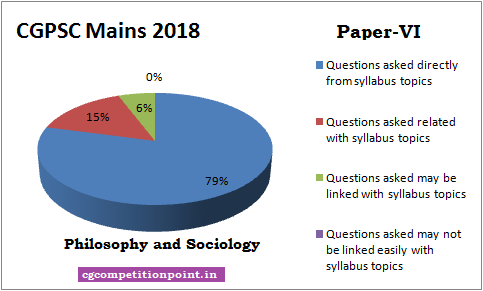
| Analysis |
| Questions asked directly from syllabus topics: 2+2+2+2+2+2+2+2+2+2+2+2+2+2+2+2+2+4+4+4+4+4+4+4+4+4+4+4+8+8+8+8+10+10+15+15+15+15= 190 Questions asked related with syllabus topics: 2+2+2+2+4+8+8+8= 36 Questions asked may be linked with syllabus topics: 2+4+8=14 Questions asked may not be linked easily with syllabus topics: 0 |
Paper –VII: General Studies- V (Laws, Programs and Organizations)
| Part 01 Welfare, Development Programme & Laws: 75 Marks
Social and Important Legislation:
- Human Rights protection Legislation 1993: 4+4
- Protection granted to Females under
- CrPC: 2
- Protection from Domestic violence Act 2005: 4
- Civil Rights protection Act 1955
- Scheduled castes and scheduled tribes Atrocity Protection Law 1989: 15
- Right to information Act 2005: 2+8
Welfare Schemes of Chhattisgarh Government:
- Customary welfare, People-oriented and Important Schemes introduced in various times by Chhattisgarh Government:
- Education: 8+15
- Health and sanitation: 4
- Food: 2
- Tribal welfare: 4
- Agriculture: 8
- Women and child: 2+2+8+15
| Part 02 International & National Sports, Events & Organisation: 50 Marks
- United Nations and its Associated Organizations: 2+4+4+10
- NGOs: 2
- International organizations: 2
- International Monetary Fund: 10
- Important bilateral groupings:
- SAARC: 2
- Other Bilateral and Regional Groups: 2+8
- National and international Sports and Competition:
- Cricket: 2
- Football: 8
| Part 03: International & National Educational Institute & their Role of Human Development: 75 Marks
- Availability of Skilled Human Resources: 2
- Employability and Productivity of Human Resources: 4+15
- Role of Various institutions and Councils in Human Resource Development as:
- National Educational Research and Training council (NCERT): 2
- University Grants Commission (UGC): 2
- Open University: 2
- Indian Council of Agriculture Research (ICAR): 4
- Indian Institute of Management (IIM): 2
- National Institute of Technology (NIT): 4
- Poly technique and ITI: 2+8
- Issues related to Girls’ Education: 2+2
- Deprived class: 4+4+8
- Issues related to Disabled People: 4

| Analysis |
| Questions asked directly from syllabus topics: 2+2+2+2+2+2+2+2+2+2+2+2+4+4+4+4+4+4+4+8+8+8+8+8+10+10+15+15= 142 Questions asked related with syllabus topics: 2+2+2+2+2+4+4+8+8+8+15= 57 Questions asked may be linked with syllabus topics: 2+2+2+2+2+4+4+4+15= 37 Questions asked may not be linked easily with syllabus topics: 4 |
Overall Analysis (except language and essay papers)
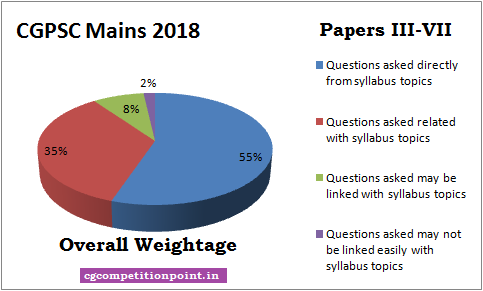
| Analysis Point | Paper III | Paper I | Paper V | Paper VI | Paper VII | Total Weightage |
| Questions asked directly from syllabus topics | 81 | 179 | 71 | 190 | 142 | 55.2% |
| Questions asked related with syllabus topics | 139 | 49 | 137 | 36 | 57 | 34.8% |
| Questions asked may be linked with syllabus topics | 8 | 10 | 28 | 14 | 37 | 8.1% |
| Questions asked may not be linked easily with syllabus topics | 12 | 2 | 4 | 0 | 4 | 1.8% |

 Home
Home Syllabus
Syllabus Contact Us
Contact Us


